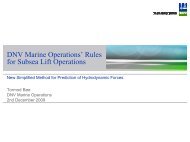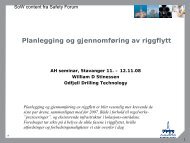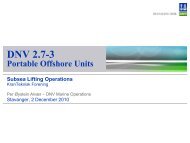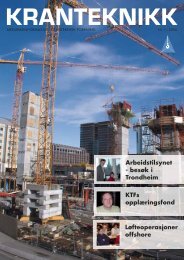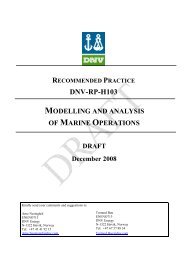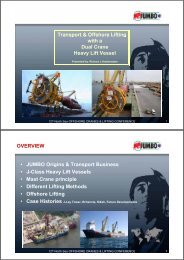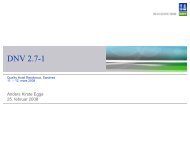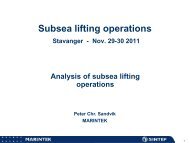Standardizing Safe Lifting Practices Offshore Canada
Standardizing Safe Lifting Practices Offshore Canada
Standardizing Safe Lifting Practices Offshore Canada
You also want an ePaper? Increase the reach of your titles
YUMPU automatically turns print PDFs into web optimized ePapers that Google loves.
<strong>Standardizing</strong> <strong>Safe</strong> <strong>Lifting</strong> <strong>Practices</strong><br />
<strong>Offshore</strong> <strong>Canada</strong><br />
Presenters:<br />
Mr. Harold Giddens, P. Eng., Senior Engineer, CNSOPB<br />
Mrs. Kelly Weir, P. Eng., CRSP, C-NLOPB C
Presentation Summary<br />
• Overview of East Coast Petroleum Industry and<br />
regulatory regime<br />
• Gap between lifting practices in our jurisdictions<br />
vs. best global practices<br />
• Gap between global codes & standards vs.<br />
Canadian regulations<br />
• Developing a standard best practice to include<br />
the design, selection, certification, cation, and<br />
maintenance of cranes, loose lifting gear, lifting<br />
devices, personnel hoists and containers<br />
<strong>Canada</strong>-Nova Scotia<br />
<strong>Offshore</strong> Petroleum Board<br />
<strong>Canada</strong>-Newfoundland and Labrador<br />
<strong>Offshore</strong> Petroleum Board<br />
2
Overview of East Coast Petroleum Industry<br />
& Regulatory Regime<br />
There are three offshore jurisdictions in <strong>Canada</strong>:<br />
• The National Energy Board (NEB) - Federal Regulatory<br />
Agency<br />
• The <strong>Canada</strong> - Nova Scotia <strong>Offshore</strong> Petroleum Board<br />
(CNSOPB) - Joint Federal and Provincial Regulatory Agency<br />
• The <strong>Canada</strong> - Newfoundland & Labrador <strong>Offshore</strong><br />
Petroleum Board (C-NLOPB)<br />
- Joint Federal and Provincial<br />
Regulatory Agency<br />
The CNSOPB and C-NLOPB C<br />
were established in 1985<br />
to manage the offshore petroleum industry following<br />
the sinking of the Ocean Ranger in 1982.<br />
<strong>Canada</strong>-Nova Scotia<br />
<strong>Offshore</strong> Petroleum Board<br />
<strong>Canada</strong>-Newfoundland and Labrador<br />
<strong>Offshore</strong> Petroleum Board<br />
3
Overview of East Coast Petroleum Industry<br />
& Regulatory Regime<br />
Jurisdictions<br />
CNSOPB<br />
C-NLOPB<br />
NEB<br />
France<br />
<strong>Canada</strong>-Nova Scotia<br />
<strong>Offshore</strong> Petroleum Board<br />
<strong>Canada</strong>-Newfoundland and Labrador<br />
<strong>Offshore</strong> Petroleum Board<br />
4
Overview of East Coast Petroleum Industry<br />
& Regulatory Regime<br />
The first well was drilled offshore Eastern <strong>Canada</strong><br />
in 1966.<br />
The following fields have been abandoned or are<br />
currently in production offshore Nova Scotia and<br />
Newfoundland & Labrador:<br />
Nova Scotia<br />
• Cohasset Panuke (1992 - 1999) - produced<br />
total of 45 million barrels of oil.<br />
• Sable Gas (1999) - industry estimate 1.6 trillion<br />
cu ft of recoverable gas reserves.<br />
<strong>Canada</strong>-Nova Scotia<br />
<strong>Offshore</strong> Petroleum Board<br />
<strong>Canada</strong>-Newfoundland and Labrador<br />
<strong>Offshore</strong> Petroleum Board<br />
5
Overview of East Coast Petroleum Industry<br />
& Regulatory Regime<br />
<strong>Canada</strong><br />
U.S.A.<br />
Nova<br />
Scotia<br />
N o v a S c o t i a<br />
Exploration<br />
Licenses<br />
N.L.<br />
The Gully<br />
0 100 200 300<br />
U.S.A.<br />
Georges Bank<br />
Kilometers<br />
<strong>Canada</strong>-Nova Scotia<br />
<strong>Offshore</strong> Petroleum Board<br />
<strong>Canada</strong>-Newfoundland and Labrador<br />
<strong>Offshore</strong> Petroleum Board<br />
6
Overview of East Coast Petroleum Industry<br />
& Regulatory Regime<br />
Newfoundland & Labrador<br />
• Hibernia (1997) - estimated 1244 million barrels<br />
of recoverable oil reserves.<br />
• Terra Nova (2002) - estimated 354 million barrels<br />
of recoverable oil reserves.<br />
• White Rose (2005) - estimated 283 million<br />
barrels of recoverable oil reserves.<br />
<strong>Canada</strong>-Nova Scotia<br />
<strong>Offshore</strong> Petroleum Board<br />
<strong>Canada</strong>-Newfoundland and Labrador<br />
<strong>Offshore</strong> Petroleum Board<br />
7
Overview of East Coast Petroleum Industry<br />
& Regulatory Regime<br />
<strong>Canada</strong>-Nova Scotia<br />
<strong>Offshore</strong> Petroleum Board<br />
<strong>Canada</strong>-Newfoundland and Labrador<br />
<strong>Offshore</strong> Petroleum Board<br />
8
Overview of East Coast Petroleum Industry<br />
& Regulatory Regime (for <strong>Lifting</strong>)<br />
Occupational<br />
Health & <strong>Safe</strong>ty<br />
Requirements<br />
Installation<br />
Regulations<br />
Certificate of<br />
Fitness<br />
Regulations<br />
Referenced Standards:<br />
•API Spec 2C - Specification for <strong>Offshore</strong> Pedestal<br />
Mounted Cranes<br />
•API RP 2D - Operation and Maintenance of<br />
<strong>Offshore</strong> Cranes<br />
•Other Referenced Standards for Electrical,<br />
Structural, Mechanical & Occupational Health &<br />
<strong>Safe</strong>ty Aspects (e.g. CSA, API, NFPA, ANSI, ASME)<br />
Independent<br />
Review by<br />
Certifying<br />
Authority<br />
Other Guidelines:<br />
•Canadian Association of Petroleum<br />
Producers (CAPP) Container<br />
Guidelines (C-NLOPB only)<br />
•CAPP Training & Qualifications<br />
Standard Practice<br />
Operator (Duty Holder's) & Facility<br />
Owners Due Diligence:<br />
• Policies & Procedures<br />
• Company required Codes & Standards<br />
• Industry Best <strong>Practices</strong>, etc.<br />
<strong>Canada</strong>-Nova Scotia<br />
<strong>Offshore</strong> Petroleum Board<br />
<strong>Canada</strong>-Newfoundland and Labrador<br />
<strong>Offshore</strong> Petroleum Board<br />
9
Overview of East Coast Petroleum Industry<br />
& Regulatory Regime<br />
Prior to this initiative, several lifting<br />
incidents had occurred. In general, most<br />
occurred due to the following:<br />
• Human error<br />
• Improper selection & use of rigging gear<br />
• Equipment failures – load hooks, slings<br />
loose gear, running wire, etc.<br />
• Inadequate safety devices<br />
• Inadequate procedures<br />
<strong>Canada</strong>-Nova Scotia<br />
<strong>Offshore</strong> Petroleum Board<br />
<strong>Canada</strong>-Newfoundland and Labrador<br />
<strong>Offshore</strong> Petroleum Board<br />
10
Overview of East Coast Petroleum Industry<br />
& Regulatory Regime<br />
Notable offshore incidents during the 1990’s<br />
• Dropped load in the sea due to crane operator<br />
error; equipment failure & inadequate safety<br />
device.<br />
• Crane boom hit upper boom stops due to<br />
equipment failure & inadequate safety device.<br />
• Boom running wire failure due to inadequate<br />
maintenance.<br />
• Headache ball falling unattended due to<br />
equipment failure and inadequate safety device in<br />
place.<br />
• Sling failure due to improper configuration &<br />
overloading.<br />
<strong>Canada</strong>-Nova Scotia<br />
<strong>Offshore</strong> Petroleum Board<br />
<strong>Canada</strong>-Newfoundland and Labrador<br />
<strong>Offshore</strong> Petroleum Board<br />
11
Overview of East Coast Petroleum Industry<br />
& Regulatory Regime<br />
The defining moment:<br />
• Boom running wire failure after crane operator<br />
hoisted four people in Billy Pugh from supply<br />
vessel to deck of an oil storage tanker.<br />
This last incident was a defining occurrence in<br />
reevaluating offshore <strong>Canada</strong> safe lifting<br />
practices. Detailed evaluation of Operators safe<br />
lifting practices was undertaken resulting in the<br />
beginning of many changes in practices and<br />
procedures. This work was the forerunner of the<br />
CAPP initiative to develop a standard lifting<br />
practice for offshore Atlantic <strong>Canada</strong>.<br />
<strong>Canada</strong>-Nova Scotia<br />
<strong>Offshore</strong> Petroleum Board<br />
<strong>Canada</strong>-Newfoundland and Labrador<br />
<strong>Offshore</strong> Petroleum Board<br />
12
Overview of East Coast Petroleum Industry<br />
& Regulatory Regime<br />
• C-NLOPB/CNSOPB regulations have both prescriptive and<br />
performance based requirements.<br />
• Some regulatory requirements are too prescriptive - not<br />
flexible.<br />
• Prescriptive requirements for some equipment (e.g. cranes)<br />
but not others (e.g. containers).<br />
• Some standards referenced in the regulations are outdated.<br />
• Some regulatory requirements are performance based<br />
(e.g. "No"<br />
person shall operate a crane under conditions that are<br />
likely to create a hazard to any person, ship, aircraft, vehicle, , load<br />
or structure or to the stability of the crane.") but no guidance is<br />
in place.<br />
• Terminology in the standards is not always clear (e.g.<br />
wording on anti two block; or lockable latches on hooks).<br />
<strong>Canada</strong>-Nova Scotia<br />
<strong>Offshore</strong> Petroleum Board<br />
<strong>Canada</strong>-Newfoundland and Labrador<br />
<strong>Offshore</strong> Petroleum Board<br />
13
GAP ANALYSIS<br />
Our Jurisdiction Vs. Best Global <strong>Practices</strong><br />
• PEDESTAL CRANE<br />
• OFFSHORE CONTAINERS<br />
• LIFTING GEAR & DEVICES<br />
• MANRIDING EQUIPMENT<br />
<strong>Canada</strong>-Nova Scotia<br />
<strong>Offshore</strong> Petroleum Board<br />
<strong>Canada</strong>-Newfoundland and Labrador<br />
<strong>Offshore</strong> Petroleum Board<br />
14
Gap Between Global Codes & Standards vs.<br />
Canadian Regulations<br />
GLOBAL CODES & STANDARDS<br />
PEDESTAL CRANE DESIGN<br />
EN 13852-1 & CERTIFYING AUTHORITY<br />
GUIDELINES (e.g. DNV)<br />
CANADIAN CODES & STANDARDS<br />
PEDESTAL CRANE DESIGN<br />
API SPEC 2C & OTHER REGULATIONS<br />
OFFSHORE CONTAINERS<br />
EN 12079 & CERTIFYING AUTHORITY<br />
GUIDELINES (e.g. DNV)<br />
OFFSHORE CONTAINERS<br />
CAPP GUIDELINES (NL ONLY)<br />
HOOKS & LOOSE GEAR<br />
VARIOUS CODES & STANDARDS<br />
MOSTLY EUROPEAN BASED<br />
MANRIDING<br />
STANDARDS & GUIDELINES<br />
NOT SPECIFIC<br />
HOOKS & LOOSE GEAR<br />
VARIOUS CODES & STANDARDS<br />
MOSTLY AMERICAN BASED<br />
NONE LEGISLATED<br />
MANRIDING<br />
STANDARDS & GUIDELINES<br />
NOT SPECIFIC<br />
<strong>Canada</strong>-Nova Scotia<br />
<strong>Offshore</strong> Petroleum Board<br />
<strong>Canada</strong>-Newfoundland and Labrador<br />
<strong>Offshore</strong> Petroleum Board<br />
15
Gap Between <strong>Lifting</strong> <strong>Practices</strong> in<br />
Our Jurisdiction Vs. Best Global <strong>Practices</strong><br />
Global Best Practice<br />
Personnel Hoists Require<br />
Independent Brake<br />
Anti Two Block designed to prohibit<br />
the hoist block assembly from<br />
striking the boom<br />
<strong>Safe</strong> Load Indicator<br />
mandatory<br />
Gross Overload Protection System<br />
mandatory<br />
Boom Radius Limiter<br />
mandatory<br />
Crane Design safety features are<br />
mandatory<br />
Canadian Practice<br />
Personnel Hoists Independent Brake<br />
not mandatory<br />
Anti Two Block device that strikes<br />
the boom is acceptable if no damage<br />
can occur<br />
<strong>Safe</strong> Load Indicator<br />
optional<br />
Gross Overload Protection System<br />
not mandatory<br />
Boom Radius Limiter<br />
not mandatory<br />
Many safety features are optional or<br />
not required<br />
<strong>Canada</strong>-Nova Scotia<br />
<strong>Offshore</strong> Petroleum Board<br />
<strong>Canada</strong>-Newfoundland and Labrador<br />
<strong>Offshore</strong> Petroleum Board<br />
16
Gap Between <strong>Lifting</strong> <strong>Practices</strong> in<br />
Our Jurisdiction Vs. Best Global <strong>Practices</strong><br />
Global Best Practice<br />
Container design specific concerning<br />
cold temperature requirements<br />
Container design, certification and<br />
maintenance to EN 12079 or equal<br />
System in place for quality assurance<br />
of lifting gear<br />
Minimum code requirements for<br />
manriding<br />
Canadian Practice<br />
Many containers designed to BS 7072<br />
and/or no cold temperature<br />
requirements<br />
No requirements for containers in NS<br />
offshore area; DNV 2.7-1 or<br />
EN 12079 in NL offshore area<br />
Adhoc criteria in place for lifting gear<br />
Minimum code requirements for<br />
manriding<br />
<strong>Canada</strong>-Nova Scotia<br />
<strong>Offshore</strong> Petroleum Board<br />
<strong>Canada</strong>-Newfoundland and Labrador<br />
<strong>Offshore</strong> Petroleum Board<br />
17
To summarize:<br />
East Coast Petroleum Industry<br />
& Regulatory Regime<br />
• Preventable incidents were occurring;<br />
• Inadequate guidance was provided for the<br />
interpretation of regulatory requirements;<br />
• Codes and practices were not standard for the<br />
industry;<br />
• Gaps between Canadian regulations and global best<br />
practices.<br />
Consequently, , the Canadian Association of Petroleum<br />
Producers (CAPP) was asked to sponsor and develop a “safe<br />
lifting practices” guideline for application in the Canadian East<br />
Coast <strong>Offshore</strong> Petroleum industry. In response, CAPP agreed<br />
and formed a task group in 2004 to complete the initiative.<br />
<strong>Canada</strong>-Nova Scotia<br />
<strong>Offshore</strong> Petroleum Board<br />
<strong>Canada</strong>-Newfoundland and Labrador<br />
<strong>Offshore</strong> Petroleum Board<br />
18
Development of a Standard Best Practice<br />
The CAPP <strong>Safe</strong> <strong>Lifting</strong> <strong>Practices</strong> Committee is<br />
comprised of the following representatives:<br />
• CAPP<br />
• CNSOPB<br />
• C-NLOPB<br />
• Certifying Authority representative<br />
• Industry Reps<br />
• Chair Person<br />
• Operators (duty holders)<br />
• Drilling Rig Owner (CAODC)<br />
<strong>Canada</strong>-Nova Scotia<br />
<strong>Offshore</strong> Petroleum Board<br />
<strong>Canada</strong>-Newfoundland and Labrador<br />
<strong>Offshore</strong> Petroleum Board<br />
19
Development of a Standard Best Practice<br />
The <strong>Safe</strong> <strong>Lifting</strong> Practice includes the<br />
following topics:<br />
• <strong>Offshore</strong> Pedestal Cranes<br />
• <strong>Offshore</strong> Containers<br />
• Loose Gear<br />
• Other <strong>Lifting</strong> Devices<br />
• Operational Best <strong>Practices</strong><br />
<strong>Canada</strong>-Nova Scotia<br />
<strong>Offshore</strong> Petroleum Board<br />
<strong>Canada</strong>-Newfoundland and Labrador<br />
<strong>Offshore</strong> Petroleum Board<br />
20
<strong>Offshore</strong> Pedestal Cranes<br />
• Cranes shall meet API Spec 2C and all<br />
other applicable regulatory requirements<br />
• In addition to API 2C - 6 th Edition, cranes<br />
shall meet the following criteria:<br />
• Critical components to meet cold temperature<br />
(Charpy) requirements;<br />
• <strong>Safe</strong> Load Indicator (SLI);<br />
• SLI to indicate all operating modes;<br />
• SLI limits, warning lights & load curves shall<br />
be approved by Certifying Authority;<br />
<strong>Canada</strong>-Nova Scotia<br />
<strong>Offshore</strong> Petroleum Board<br />
<strong>Canada</strong>-Newfoundland and Labrador<br />
<strong>Offshore</strong> Petroleum Board<br />
21
<strong>Offshore</strong> Pedestal Cranes<br />
Continued…<br />
• Cargo hooks shall have positive close latch to<br />
prevent sling shedding;<br />
• Only IWRC running wire permitted;<br />
• Hooks used for hoisting personnel shall be<br />
equipped with spring loaded latch & pin insert<br />
for positive closure;<br />
• Manriding hoists certified by the Certifying<br />
Authority and nameplate installed;<br />
• Independent secondary brakes on manriding<br />
hoists capable of being tested independently;<br />
<strong>Canada</strong>-Nova Scotia<br />
<strong>Offshore</strong> Petroleum Board<br />
<strong>Canada</strong>-Newfoundland and Labrador<br />
<strong>Offshore</strong> Petroleum Board<br />
22
<strong>Offshore</strong> Pedestal Cranes<br />
Continued…<br />
• Overload protection system on running wire;<br />
• Boom down (radius) overload limiter;<br />
• Personnel emergency load lowering;<br />
• Inspected in accordance with API 2C, API RP2D<br />
and manufacturer recommendations.<br />
<strong>Canada</strong>-Nova Scotia<br />
<strong>Offshore</strong> Petroleum Board<br />
<strong>Canada</strong>-Newfoundland and Labrador<br />
<strong>Offshore</strong> Petroleum Board<br />
23
<strong>Offshore</strong> Containers<br />
• Containers approved for offshore use shall meet the<br />
following criteria:<br />
• Certified by Certifying Authority or approved 3rd party;<br />
• Designed to meet cold temperature requirements;<br />
• Certification to meet EN 12079, DNV 2.7-1, or equal;<br />
• Sling sets stay with the container;<br />
• Design & risk assessment required for one-of of lifts,<br />
containers that do not meet safe lifting practices, or<br />
other uncertified lifts;<br />
• Inspected regularly in accordance with the rules or<br />
standard to which they were designed, constructed,<br />
tested, and certified.<br />
<strong>Canada</strong>-Nova Scotia<br />
<strong>Offshore</strong> Petroleum Board<br />
<strong>Canada</strong>-Newfoundland and Labrador<br />
<strong>Offshore</strong> Petroleum Board<br />
24
General Criteria:<br />
Loose Gear<br />
• Applicable reference code, standard or rule<br />
referenced for each type;<br />
• Meet cold temperature criteria for critical<br />
components;<br />
• Proof load tests to take into service;<br />
• All terminations to be “Quenched & Tempered”;<br />
• Inspected and tested by a third party and pre-<br />
use inspection conducted to meet code<br />
requirements;<br />
• Standardized color coding.<br />
<strong>Canada</strong>-Nova Scotia<br />
<strong>Offshore</strong> Petroleum Board<br />
<strong>Canada</strong>-Newfoundland and Labrador<br />
<strong>Offshore</strong> Petroleum Board<br />
25
Specific Criteria:<br />
Loose Gear<br />
• Cargo Hooks in the Load Path below the<br />
Crane Hook<br />
• CoC EN 10204 – 3.2b where SWL ≥ 10 tonne<br />
• CoC EN 10204 – 3.1b where SWL < 10 tonne<br />
• ASME Self-Locking Eye Hooks when used shall<br />
have trigger guards to protect the latch from<br />
depressing and possible unassisted opening<br />
due to coming into contact with an object<br />
<strong>Canada</strong>-Nova Scotia<br />
<strong>Offshore</strong> Petroleum Board<br />
<strong>Canada</strong>-Newfoundland and Labrador<br />
<strong>Offshore</strong> Petroleum Board<br />
26
Loose Gear<br />
ASME Self-Locking Eye Hook<br />
Trigger Guard<br />
<strong>Canada</strong>-Nova Scotia<br />
<strong>Offshore</strong> Petroleum Board<br />
No Trigger Guard<br />
<strong>Canada</strong>-Newfoundland and Labrador<br />
<strong>Offshore</strong> Petroleum Board<br />
27
Specific Criteria,<br />
Specific<br />
Loose Gear<br />
Criteria, continued…<br />
• Wire Rope & Chain Slings<br />
• Shackles, Pins, Master Links, Connecting Links (“D”(<br />
Links) require CoC – EN 10204 – 3.1b certificate c/w<br />
charpy values.<br />
• Flat Webbing & Round Man Made Fiber Slings<br />
• Minimum Factor of <strong>Safe</strong>ty = 6:1<br />
• Batch testing shall establish SWL of production run<br />
• Pull testing of production slings not permitted<br />
• Not to be used for general cargo or container handling<br />
• Natural fiber round slings not permitted<br />
<strong>Canada</strong>-Nova Scotia<br />
<strong>Offshore</strong> Petroleum Board<br />
<strong>Canada</strong>-Newfoundland and Labrador<br />
<strong>Offshore</strong> Petroleum Board<br />
28
Other <strong>Lifting</strong> Devices<br />
• Standard <strong>Practices</strong> includes minimum code<br />
requirements for:<br />
• Mobile Cranes<br />
• Overhead and Gantry Cranes<br />
• Drilling Hoisting Tools & Equipment<br />
• Forklifts<br />
• Manriding Work Baskets including lift sets<br />
• Pad Eyes (Structural)<br />
• Personnel Transfer Devices (for marine transfers)<br />
• Cargo winches<br />
• Personnel Hoisting Winches<br />
• Running wire rope (cranes, lifeboat falls)<br />
<strong>Canada</strong>-Nova Scotia<br />
<strong>Offshore</strong> Petroleum Board<br />
<strong>Canada</strong>-Newfoundland and Labrador<br />
<strong>Offshore</strong> Petroleum Board<br />
29
Some examples are:<br />
• Work Baskets<br />
Other <strong>Lifting</strong> Devices<br />
• Designed to meet EN 12079 or equal<br />
• Meet cold temperature criteria<br />
• Certified for manriding by the Certifying<br />
Authority<br />
• CoC - EN 10204 – 3.2b certification<br />
• Labeled “Manriding Only”<br />
• Secondary safety pendant to maximize<br />
redundancy of components in the load path<br />
<strong>Canada</strong>-Nova Scotia<br />
<strong>Offshore</strong> Petroleum Board<br />
<strong>Canada</strong>-Newfoundland and Labrador<br />
<strong>Offshore</strong> Petroleum Board<br />
30
Other <strong>Lifting</strong> Devices<br />
• Personnel Transfer Devices<br />
• CoC - EN 10204 3.2 certification<br />
• The unit should be made of a solid construction or<br />
assembled to a solid construction and protect personnel<br />
from falling by allowing them to ride on the inside either<br />
standing or seated.<br />
• Certified for manriding by the Certifying Authority<br />
• Meet cold temperature criteria.<br />
• Manufacturer shall supply operating procedures and a<br />
training package for the device and maintenance and<br />
inspection procedures.<br />
• Secondary safety pendant to maximize redundancy of<br />
components in the load path.<br />
<strong>Canada</strong>-Nova Scotia<br />
<strong>Offshore</strong> Petroleum Board<br />
<strong>Canada</strong>-Newfoundland and Labrador<br />
<strong>Offshore</strong> Petroleum Board<br />
31
Other <strong>Lifting</strong> Devices<br />
• Winches (other than crane winches, personnel lifting)<br />
• Certified for manriding by manufacturer with<br />
nameplate installed stating “Approved for Manriding<br />
Only”<br />
• Certified for manriding by the Certifying Authority<br />
• Critical components to meet cold temperature criteria<br />
• Emergency shutdown between power source and hoist<br />
• Overload and overhoist limits<br />
• Overspeed limit safety device on electric powered<br />
winches<br />
• Emergency load lowering capability<br />
• Drum guards and spooling devices<br />
• All equipment used in manriding designated for that<br />
purpose only<br />
<strong>Canada</strong>-Nova Scotia<br />
<strong>Offshore</strong> Petroleum Board<br />
<strong>Canada</strong>-Newfoundland and Labrador<br />
<strong>Offshore</strong> Petroleum Board<br />
32
Other <strong>Lifting</strong> Devices<br />
• Wire Rope Terminations (if used in manriding)<br />
• Minimum Factor of <strong>Safe</strong>ty = 10 against failure<br />
• Proof load test certificates required for<br />
components and assembly<br />
• EN 10204 - 3.1b certificates required for<br />
components c/w charpy values<br />
• Pad Eyes (if used in manriding)<br />
• Meet cold temperature requirements<br />
• Minimum Factor of <strong>Safe</strong>ty = 10 against failure<br />
• Proof load tested prior to taking into service<br />
• Crack detection inspection annually<br />
<strong>Canada</strong>-Nova Scotia<br />
<strong>Offshore</strong> Petroleum Board<br />
<strong>Canada</strong>-Newfoundland and Labrador<br />
<strong>Offshore</strong> Petroleum Board<br />
33
Other <strong>Lifting</strong> Devices<br />
• Hooks in the Load Path (if used in<br />
manriding)<br />
• Minimum Factor of <strong>Safe</strong>ty = 12 against<br />
failure<br />
• Meet cold temperature requirements<br />
• Spring loaded latch system that can be<br />
locked with a pin or other positive<br />
mechanism to ensure the pin cannot<br />
open under any circumstances<br />
• ASME self-locking locking eye hooks not<br />
permitted<br />
<strong>Canada</strong>-Nova Scotia<br />
<strong>Offshore</strong> Petroleum Board<br />
<strong>Canada</strong>-Newfoundland and Labrador<br />
<strong>Offshore</strong> Petroleum Board<br />
34
Other <strong>Lifting</strong> Devices<br />
• Hoist Harness System for manriding<br />
operations<br />
• Meet occupational safety requirements<br />
for fall protection<br />
• Bosun chair integrated with full body<br />
harness required<br />
• Independent fall protection required to<br />
be fitted to full body harness<br />
• Rescue and recovery arrangements<br />
<strong>Canada</strong>-Nova Scotia<br />
<strong>Offshore</strong> Petroleum Board<br />
<strong>Canada</strong>-Newfoundland and Labrador<br />
<strong>Offshore</strong> Petroleum Board<br />
35
Other <strong>Lifting</strong> Devices<br />
Hoist Harness System for Manriding Operations<br />
<strong>Canada</strong>-Nova Scotia<br />
<strong>Offshore</strong> Petroleum Board<br />
<strong>Canada</strong>-Newfoundland and Labrador<br />
<strong>Offshore</strong> Petroleum Board<br />
36
Other <strong>Lifting</strong> Devices<br />
<strong>Canada</strong>-Nova Scotia<br />
<strong>Offshore</strong> Petroleum Board<br />
<strong>Canada</strong>-Newfoundland and Labrador<br />
<strong>Offshore</strong> Petroleum Board<br />
37
Operational Best <strong>Practices</strong><br />
• Documented processes for all aspects of<br />
lifting operations (Routine & Non-Routine)<br />
• <strong>Lifting</strong> equipment register<br />
• Identification of safe lift zone<br />
• Defined communication protocols<br />
<strong>Canada</strong>-Nova Scotia<br />
<strong>Offshore</strong> Petroleum Board<br />
<strong>Canada</strong>-Newfoundland and Labrador<br />
<strong>Offshore</strong> Petroleum Board<br />
38
Operational Best <strong>Practices</strong><br />
• <strong>Safe</strong> <strong>Lifting</strong> <strong>Practices</strong> developed for:<br />
• Inboard/Outboard Lifts<br />
• Cargo Handling<br />
• Loading/Offloading Supply Vessels<br />
• Handling of Drilling Tubulars<br />
• Non-routine<br />
• Use of tag lines<br />
• Handling of containers<br />
• Marine personnel transfers<br />
• Manriding operations<br />
<strong>Canada</strong>-Nova Scotia<br />
<strong>Offshore</strong> Petroleum Board<br />
<strong>Canada</strong>-Newfoundland and Labrador<br />
<strong>Offshore</strong> Petroleum Board<br />
39
Approval & Implementation of<br />
CAPP <strong>Safe</strong> <strong>Lifting</strong> Practice<br />
• Approved by CAPP Atlantic <strong>Canada</strong><br />
Committee – April 18, 2007<br />
• Approval by CNSOPB & C-NLOPB C<br />
–<br />
scheduled for May 15, 2007<br />
• Issued on CAPP website by June 2007<br />
• Implementation by all stakeholders<br />
• Full compliance by June 2008<br />
• Revise as necessary by June 2008<br />
<strong>Canada</strong>-Nova Scotia<br />
<strong>Offshore</strong> Petroleum Board<br />
<strong>Canada</strong>-Newfoundland and Labrador<br />
<strong>Offshore</strong> Petroleum Board<br />
40
Questions<br />
Further information can be obtained<br />
from the following websites:<br />
CNSOPB - www.cnsopb.ns.ca<br />
C-NLOPB<br />
- www.cnlopb.nl.ca<br />
CAPP - www.capp.ca<br />
<strong>Canada</strong>-Nova Scotia<br />
<strong>Offshore</strong> Petroleum Board<br />
<strong>Canada</strong>-Newfoundland and Labrador<br />
<strong>Offshore</strong> Petroleum Board<br />
41



